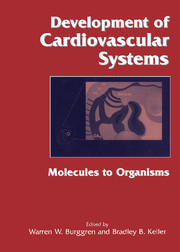Book contents
- Frontmatter
- Contents
- List of contributors
- Foreword by Constance Weinstein
- Introduction: Why study cardiovascular development?
- Part I Molecular, cellular, and integrative mechanisms determining cardiovascular development
- 1 Genetic dissection of heart development
- 2 Cardiac membrane structure and function
- 3 Development of the myocardial contractile system
- 4 Vasculogenesis and angiogenesis in the developing heart
- 5 Extracellular matrix maturation and heart formation
- 6 Endothelial cell development and its role in pathogenesis
- 7 Embryonic cardiovascular function, coupling, and maturation: A species view
- 8 Hormonal systems regulating the developing cardiovascular system
- Part II Species diversity in cardiovascular development
- Part III Environment and disease in cardiovascular development
- Epilogue: Future directions in developmental cardiovascular sciences
- References
- Systematic index
- Subject index
6 - Endothelial cell development and its role in pathogenesis
from Part I - Molecular, cellular, and integrative mechanisms determining cardiovascular development
Published online by Cambridge University Press: 10 May 2010
- Frontmatter
- Contents
- List of contributors
- Foreword by Constance Weinstein
- Introduction: Why study cardiovascular development?
- Part I Molecular, cellular, and integrative mechanisms determining cardiovascular development
- 1 Genetic dissection of heart development
- 2 Cardiac membrane structure and function
- 3 Development of the myocardial contractile system
- 4 Vasculogenesis and angiogenesis in the developing heart
- 5 Extracellular matrix maturation and heart formation
- 6 Endothelial cell development and its role in pathogenesis
- 7 Embryonic cardiovascular function, coupling, and maturation: A species view
- 8 Hormonal systems regulating the developing cardiovascular system
- Part II Species diversity in cardiovascular development
- Part III Environment and disease in cardiovascular development
- Epilogue: Future directions in developmental cardiovascular sciences
- References
- Systematic index
- Subject index
Summary
Introduction
The endothelium is a single layer of cells that lines the intimal surface of the circulatory system of vertebrates. Initially, the endothelial cell (EC) was thought to function as only a passive inert barrier between the circulating blood and surrounding tissue. However, it is now evident that the endothelium is an important physiological and metabolic organ with broad paracrine and endocrine activity (Pearson, 1991). The EC population is not homogeneous. It displays remarkable phenotypic and functional differences not only between species but also within the same organism (Fajardo, 1989). This chapter will review some current knowledge on the morphogenesis, development, and maturation of the EC and its physiologic and metabolic roles. Also, it will discuss the potential role of developmental aberrations in endothelial function in pathogenesis.
Endothelial cell development
Vasculogenesis and angiogenesis
The embryonic development of the endothelium has been closely studied in conjunction with the development and maturation of blood vessels. Embryonic ECs and their precursors are very different from mature adult cells. The metamorphosis of embryonic ECs may occur in less than 24 hours, whereas adult cells may not change for more than 20 years (Pardanaud & Dieterlen-Lievre, 1993). Endothelial precursors arise from the differentiation of mesodermal aggregates called blood islands found in the yolk sac (Risau et al., 1988). The outer layers of the island develop into endothelial precursors, and the inner cells form the hematopoietic stem cells.
During the embryonic period, extensive proliferation and remodeling of the ECs are required in the development of the regional circulation (Risau & Lemmon, 1988). Despite limited techniques, by the beginning of this century the vascular endothelium was noted to originate from both extra- and intraembryonic sources (Evans, 1909).
- Type
- Chapter
- Information
- Development of Cardiovascular SystemsMolecules to Organisms, pp. 57 - 64Publisher: Cambridge University PressPrint publication year: 1998



